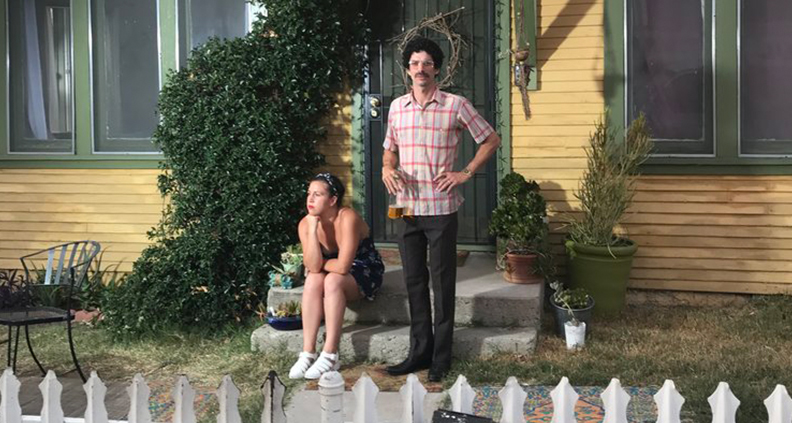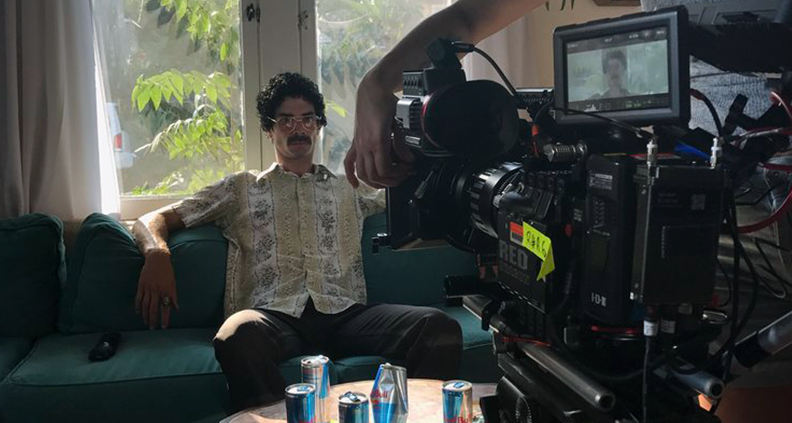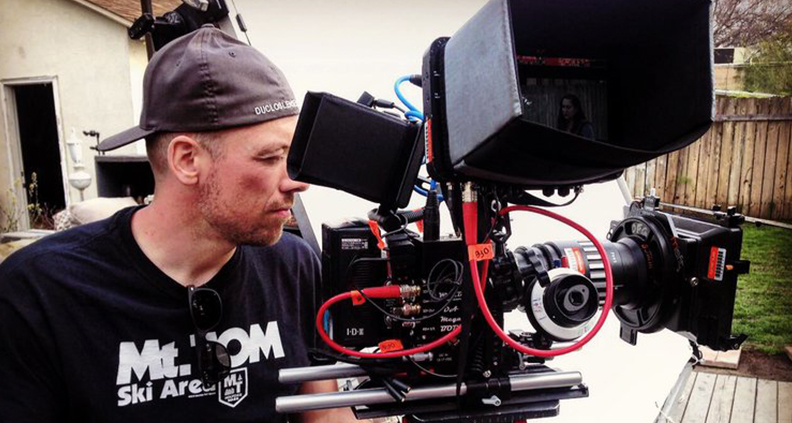Mistakes and Mustaches: How My Friends and I Made a Hit Two-Hour Web Series
In this special guest post, indie filmmaker Kyle Kenyon takes us behind the scenes of his 2019 web series Schmotts, which continues to be programmed—and win awards!—at film festivals worldwide. Enjoy!
***
In college, I wrote my first one-act play. Our professor said the only requirement was for each play to be about 10 pages. Mine was over 30. Looking back, it makes sense that I ended up directing a web series that’s nearly two hours long.
A few years ago, I was in a creative slump. I’d lived in LA for six years, and in that time, I hadn’t made much (or any) progress toward my dream of becoming a director. I worked a full-time post-production job unrelated to my goals and spent what little free time I had doing improv comedy for single-digit crowds.
One day while talking to Matt Stauter, a friend I’d done years of comedy shows with, I mentioned that I wanted to start really focusing on directing. He told me he had a script that could be a fun short film for us to make together. He downplayed it a lot, but it sounded like the kind of thing I wanted to direct. It was called, for reasons I still don’t quite know, Uncle Gary. It was about an annoying stepdad—played by Matt—who can’t stop talking about his beloved 1956 Corvette.
We got together with two of our other comedy friends (my girlfriend Nina Concepción and my neighbor AJ Salas) and shot the whole thing in my kitchen one morning. The scene called for beer so we ordered a beer delivery at 11 a.m., drank them all, and had a great time making this silly little short.
Then we watched it.
The quality was awful. The continuity was a nightmare, the sound was atrocious, and my complete lack of DP skills made it too shaky to watch without motion sickness medication.
But… it made us laugh. We found ourselves quoting it in text threads all the time, and I thought, “Hmm, maybe this was something we shouldn’t just forget about.”
So we talked about re-shooting it with someone else operating the camera. Matt showed it to his cinematographer friend Mark LaFleur—an actual professional—who said he would be interested in shooting it for us.
Having Mark involved made us all step our game up. We got a better location, a tiny crew, and even bought one of our actors a fancy new wig… because the previous one got ruined. We shot the new seven-minute short (now titled Schmotts, after the last name of the main character) in one day. A few months later, it was finished.

Schmotts made it into a few festivals, and our experiences at them ranged from “we won the audience award” to “an old lady said she hated it.” But the quality jump from our first version to our second version was huge, and we all wanted to keep working together keep getting better. So we decided to make a “second episode.”
That episode ended up being 24 minutes long.
At this point, we didn’t know what we were supposed to do with it. We all liked the episode and knew the length was what made it work, but who’s going to watch a 24-minute “sequel” to a seven-minute short film that nobody really watched in the first place? Maybe that didn’t make sense, but it was a reason to keep working on this project—and that was reason enough for me.
Over the next three years, we wrote, shot, and edited a total of five 22-minute episodes of Schmotts. These episodes (which we jokingly referred to as “an HBO Limited Series” while shooting) make up our first season. It was a crazy process, and I think most of our friends thought we were working on something that would never get finished. And there were times when I worried they might be right.
We had one particular episode that took place entirely outdoors at a backyard party. We shot everything in southern California, so that never seemed like an issue… on paper. When it came time to shoot, we got rained out three different days. Each time, we had to tell our actors that we were sorry and ask them if they could come back the following weekend. Luckily, they always did.
After the first year of shooting, time began to be a challenge of its own; one of our actors had a dramatic weight loss and Matt himself had to have a few weeks’ notice before every shoot so he could grow his character’s mustache. Since the episodes all take place around the same time, continuity was a constant worry. Eventually Matt just kept this crazy mustache all the time, in case we suddenly had a free weekend to shoot some more scenes. It was a sacrifice indeed.
Our location was another challenge. Most of our episodes take place at the Schmotts family home, which is a real house that belongs to some friends of ours. Every time we shot at their house, they were gracious enough to not only work with our schedule, even going as far as to take their three-year-old child and leaving town for a few days. Having an entire house to ourselves with no worries was the biggest advantage we had in this whole process, and without that, I’m sure we never would’ve gotten this going.
Weekends were our only available days to shoot so I often had to tell friends, “Sorry, I can’t go to [social event] because I’m shooting this… TV show thing?” I’m sure it sounded crazy to be working on a web series for three years, but I was lucky to work with a crew ambitious enough to commit to that.

About a year into the process, I got in a pretty bad car wreck. I was physically fine, but my car was totaled and I owed a lot of money to the other driver involved. It was the first time I really considered moving back to Missouri to live an easier (or perhaps just cheaper) life. The thought of trying to buy a new car while spending money to make Schmotts seemed impossible.
Fortunately, our crew came through and pitched in to help with our expenses from then on. Nina constantly encouraged me to keep working on this and not quit because of this first setback. AJ, one of our lead actors who turned into one of our producers as well, even loaned me money to pay an actor when I realized my bank account was overdrawn at the end of a shoot. I can’t stress enough how much harder this project would’ve been if we hadn’t worked so closely as a team.
Speaking of our team, I think the most important (and maybe only) “rule” we had while making “Schmotts” was that we wouldn’t work with anyone we didn’t genuinely like, and we wouldn’t work with anyone we didn’t think was genuinely talented. It can be tempting to hire your friend just because you like them and they’re convenient; it can be so easy to let your buddy run sound because he’ll do it for free and wants to learn.
I think one of the biggest tools you can have as a director is to recognize talent and skill. If your friend isn’t a perfect fit for the job, find someone who is. It’s fun to work with your friends but shooting only lasts a little while. The project you make will last much longer, and you’re letting down the whole crew if you don’t get the best people you can. It doesn’t mean your friends aren’t talented, but there will be other opportunities to hire your friends when it’s a perfect fit, and I think that distinction is crucial.
Once the sound, color and music were complete, we realized we had nearly two hours of our own show—and nowhere for anyone to see it. Would people really sit down and watch something this long on YouTube or Vimeo? I didn’t think they would, so we decided to just throw a premiere party and show it to our friends in a theater. I cut a quick trailer, and before long, we had quite a few friends asking when they could watch it. A huge reason for their interest was the overall look of the show; Mark’s cinematography was gorgeous, and looking back at it, I can’t believe I ever thought I could shoot this myself.
Again, we got really lucky (the theme of this entire project?) when a friend offered to let us use the theater she worked at to host our premiere in January of last year. We promoted it like crazy with free food, free drinks and—maybe most importantly—free parking. Over 200 people showed up to watch three episodes. The response was really positive, and several people mentioned that they couldn’t believe this was finally done. To be honest, I couldn’t believe it was either.
After that screening, we started submitting to festivals. Sometimes we submitted as a web series, and sometimes we just submitted the pilot episode as its own standalone short film. Overall, we got into quite a few, with everyone in our core group winning awards at some point. The festival experience was really fun and a great opportunity to see what kind of audience a project appeals to. It also gave us the chance to network which, it turns out, we aren’t very good at doing!

Although we are still technically in the running for a few more festivals, we released the entire first season of Schmotts online in October. As far as the next step goes, I’m not sure what will happen. I’ve written a second season, but ideally, we’d all love to sell it to a streaming service of some kind and, of course, get paid to make more episodes.
Without a manager or agent, this is a difficult thing to navigate, and I’m still learning as I go. It’s a hard thing to figure out when you don’t know anyone who has made a series this long before. But in the long run, what all of us really care about is that people watch it and hopefully enjoy it. If anything, it’s given me three solid years of experience that I never would’ve gotten if we hadn’t committed to making that weird short video in my kitchen over three years ago!
To learn more about Schmotts and watch the entire first season, visit Schmotts.com.